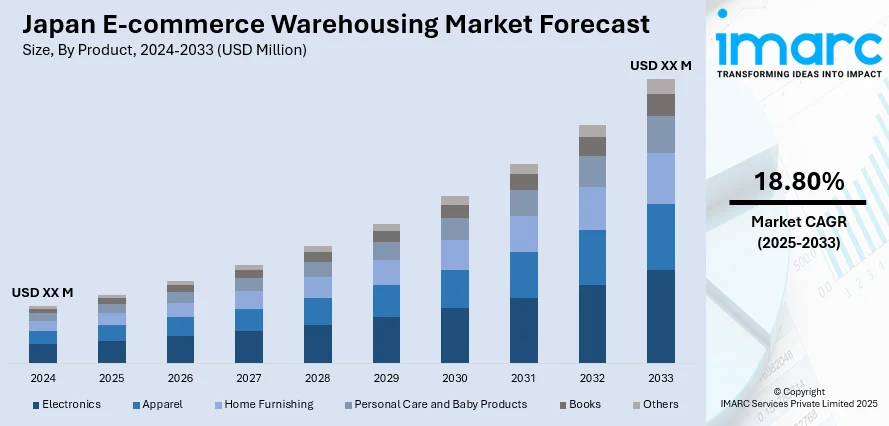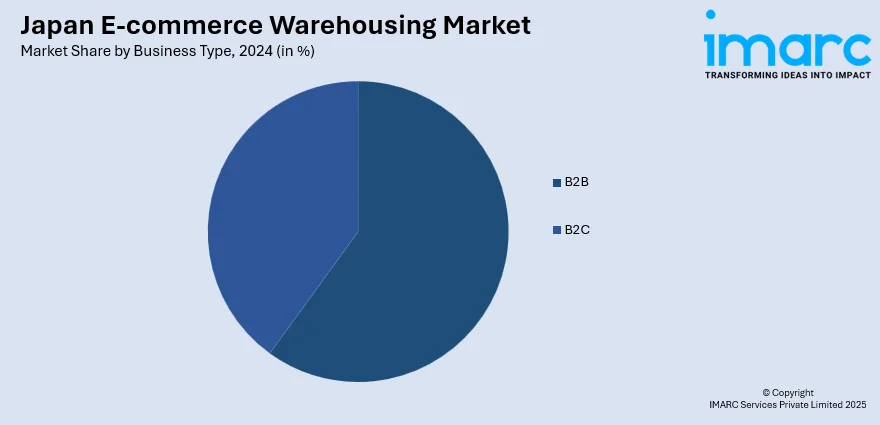
Japan E-commerce Warehousing Market Size, Share, Trends and Forecast by Product, Business Type, Component, and Region, 2025-2033
Japan E-commerce Warehousing Market Overview:
The Japan e-commerce warehousing market size is projected to expand at a growth rate (CAGR) of 18.80% during 2025-2033. Presently, rising online shopping trends are positively influencing the market. Retailers and third-party logistics companies are investing in intelligent warehousing solutions to fulfill user demands for quick and adaptable deliveries. Besides this, the growing adoption of artificial intelligence (AI), which assists in automating stock control, forecasting demand trends, and enhancing storage efficiency, is contributing to the expansion of the Japan e-commerce warehousing market share.
|
Report Attribute
|
Key Statistics
|
|---|---|
|
Base Year
|
2024 |
|
Forecast Years
|
2025-2033
|
|
Historical Years
|
2019-2024
|
| Market Growth Rate 2025-2033 | 18.80% |
Japan E-commerce Warehousing Market Trends:
Rising online shopping trends
The growing online shopping trends are positively influencing the market in Japan. As people are preferring the convenience of ordering products online, e-commerce companies are experiencing a surge in the demand for efficient storage and order fulfillment solutions. According to the PCMI, 76% of the Japanese population, equating to 94 Million individuals, purchased goods online, highlighting the extensive influence of e-commerce nationwide. The increasing frequency of online purchases, including groceries, electronics, clothing, and personal care products, is enabling businesses to maintain larger and more organized inventories. This is leading to a rise in the construction and leasing of modern warehousing spaces. Warehouses play a significant role in reducing delivery times, improving customer satisfaction, and handling returns effectively. In Japan, where space is limited and urban areas are densely populated, companies are seeking strategically located warehouses to facilitate quicker last-mile delivery. The growing online shopping behavior is also promoting the adoption of automation and inventory management systems to handle high order volumes accurately and efficiently. Retailers and third-party logistics providers are investing in smart warehousing solutions to meet user expectations for fast, accurate, and flexible deliveries. As online sales are rising across categories, the need for dynamic and scalable warehousing infrastructure is becoming important. Japan’s tech-savvy population and widespread internet access are further supporting the market growth.

Increasing utilization of AI
Rising usage of AI is impelling the Japan e-commerce warehousing market growth. As per the IMARC Group, the Japan AI market size was valued at USD 6.6 Billion in 2024. As e-commerce platforms continue to expand, companies rely more on AI to manage complex warehousing operations with speed and accuracy. AI aids in automating inventory management, predicting demand patterns, and optimizing storage space. It improves picking and packing processes, minimizing human errors and speeding up order fulfillment. In Japan, where efficiency and precision are highly valued, AI solutions enable warehouses to operate with minimal delays and greater productivity. AI-based robots assist in handling goods, while machine learning (ML) algorithms analyze buying trends to ensure timely stock replenishment. These technologies also support real-time tracking of inventory, helping companies manage supply chains more efficiently. Additionally, AI enhances last-mile delivery planning by analyzing routes and reducing delivery times. The utilization of AI lowers operational costs, increases customer satisfaction, and improves warehouse scalability.
Japan E-commerce Warehousing Market Segmentation:
IMARC Group provides an analysis of the key trends in each segment of the market, along with forecasts at the country and regional levels for 2025-2033. Our report has categorized the market based on product, business type, and component.
Product Insights:
- Electronics
- Apparel
- Home Furnishing
- Personal Care and Baby Products
- Books
- Others
The report has provided a detailed breakup and analysis of the market based on the product. This includes electronics, apparel, home furnishing, personal care and baby products, books, and others.
Business Type Insights:

- B2B
- B2C
A detailed breakup and analysis of the market based on the business type have also been provided in the report. This includes B2B and B2C.
Component Insights:
- Hardware Equipment
- Software
The report has provided a detailed breakup and analysis of the market based on the component. This includes hardware equipment and software.
Regional Insights:
- Kanto Region
- Kansai/Kinki Region
- Central/Chubu Region
- Kyushu-Okinawa Region
- Tohoku Region
- Chugoku Region
- Hokkaido Region
- Shikoku Region
The report has also provided a comprehensive analysis of all the major regional markets, which include Kanto Region, Kansai/Kinki Region, Central/Chubu Region, Kyushu-Okinawa Region, Tohoku Region, Chugoku Region, Hokkaido Region, and Shikoku Region.
Competitive Landscape:
The market research report has also provided a comprehensive analysis of the competitive landscape. Competitive analysis such as market structure, key player positioning, top winning strategies, competitive dashboard, and company evaluation quadrant has been covered in the report. Also, detailed profiles of all major companies have been provided.
Japan E-commerce Warehousing Market News:
- In December 2024, JD Logistics launched its first self-managed warehouse in Japan. The center aimed to offer comprehensive e-commerce supply chain solutions for companies in Japan and South Korea, along with international brands entering these markets. It featured numerous warehousing robots, sorting robots, and automated operation lines, significantly increasing processing efficiency compared to conventional manual methods.
- In February 2024, Geekplus collaborated with Alpen to introduce its shelf-to-person solution to the firm’s new 33,000-square-meter e-commerce warehouse in Western Japan. The site, situated in Inazawa City, Aichi Prefecture, was intended to create a network that could provide rapid and efficient supply to the market.
Japan E-commerce Warehousing Market Report Coverage:
| Report Features | Details |
|---|---|
| Base Year of the Analysis | 2024 |
| Historical Period | 2019-2024 |
| Forecast Period | 2025-2033 |
| Units | Million USD |
| Scope of the Report | Exploration of Historical Trends and Market Outlook, Industry Catalysts and Challenges, Segment-Wise Historical and Future Market Assessment:
|
| Products Covered | Electronics, Apparel, Home Furnishing, Personal Care and Baby Products, Books, Others |
| Business Types Covered | B2B, B2C |
| Components Covered | Hardware Equipment, Software |
| Regions Covered | Kanto Region, Kansai/Kinki Region, Central/Chubu Region, Kyushu-Okinawa Region, Tohoku Region, Chugoku Region, Hokkaido Region, Shikoku Region |
| Customization Scope | 10% Free Customization |
| Post-Sale Analyst Support | 10-12 Weeks |
| Delivery Format | PDF and Excel through Email (We can also provide the editable version of the report in PPT/Word format on special request) |
Key Questions Answered in This Report:
- How has the Japan e-commerce warehousing market performed so far and how will it perform in the coming years?
- What is the breakup of the Japan e-commerce warehousing market on the basis of product?
- What is the breakup of the Japan e-commerce warehousing market on the basis of business type?
- What is the breakup of the Japan e-commerce warehousing market on the basis of component?
- What is the breakup of the Japan e-commerce warehousing market on the basis of region?
- What are the various stages in the value chain of the Japan e-commerce warehousing market?
- What are the key driving factors and challenges in the Japan e-commerce warehousing market?
- What is the structure of the Japan e-commerce warehousing market and who are the key players?
- What is the degree of competition in the Japan e-commerce warehousing market?
Key Benefits for Stakeholders:
- IMARC’s industry report offers a comprehensive quantitative analysis of various market segments, historical and current market trends, market forecasts, and dynamics of the Japan e-commerce warehousing market from 2019-2033.
- The research report provides the latest information on the market drivers, challenges, and opportunities in the Japan e-commerce warehousing market.
- Porter's five forces analysis assist stakeholders in assessing the impact of new entrants, competitive rivalry, supplier power, buyer power, and the threat of substitution. It helps stakeholders to analyze the level of competition within the Japan e-commerce warehousing industry and its attractiveness.
- Competitive landscape allows stakeholders to understand their competitive environment and provides an insight into the current positions of key players in the market.
Need more help?
- Speak to our experienced analysts for insights on the current market scenarios.
- Include additional segments and countries to customize the report as per your requirement.
- Gain an unparalleled competitive advantage in your domain by understanding how to utilize the report and positively impacting your operations and revenue.
- For further assistance, please connect with our analysts.
 Request Customization
Request Customization
 Speak to an Analyst
Speak to an Analyst
 Request Brochure
Request Brochure
 Inquire Before Buying
Inquire Before Buying




.webp)




.webp)












